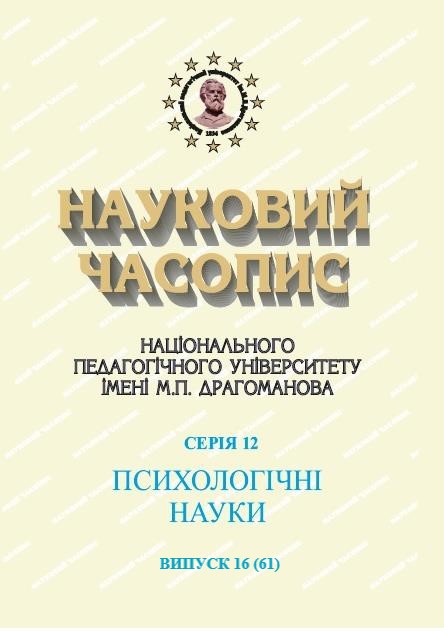PSYCHOLOGICAL REHABILITATION OF PSYCHOSOMATIC PATIENTS OF WORKING AGE
DOI:
https://doi.org/10.31392/NPU-nc.series12.2021.16(61).06Keywords:
medical and psychological rehabilitation, psychocorrection program, psychosomatic problems, psychodiagnostic criteria, optimal functioning of people.Abstract
The purpose of the article is to substantiate the psychological rehabilitation of psychosomatic patients of working age. Research methods: questionnaire MTZHTs (morphological test of living values); Wiesbaden Questionnaire (WIPPF), Giessen Somatic Complaints Questionnaire, “Four-dimensional questionnaire to assess distress, depression, anxiety and somatization”. The clinical diagnosis of hypochondriac disorders was established according to research psychodiagnostic criteria in the section of the International Classification of Diseases 10th revision (MKH-10: class V. Mental and behavioral disorders). Expert assessment and interview (Structural interview with Otto Kernberg) were also used. The criteria of psychosomatic compliance with the optimal state of organism functioning in the study group include cognitive, physiological and behavioral ones. Results. The components of the model “Psychological rehabilitation of psychosomatic patients of working age” are presented, which emphasizes the content, forms, methods of organizational and methodological principles of forming the readiness of professionals for professional self-realization and safety. Conclusions. Objectivity in substantiating the topic was ensured by implementing unbiased, non-opportunistic generalizations based on the views of previous researchers, and verified information from reliable sources. Psycho-correctional work was aimed at strengthening personal preventive resources and included a set of measures aimed at improving the level of cognitive, emotional and behavioral intelligence and cognitive-basic, propaedeutic-value, generalizing-corrective and constructive-procedural criteria. The levels of compliance with the criteria of psychosomatic health in the respondents are presented, the characteristic disfunctions of which are monotonous, emotionally primitive complaints, which are supported by a set of documents accumulated during the survey period.
References
- Viznyuk, I.M. (2019). Psychosomatic relations in the aspect of development of the hypochondriacal behavior of the individual [Psychosomatic correlates in terms of the development of hypochondriac personality behavior]. Psykholohichnyi chasopys –Psychological hour, 8 (7), 174–188. doi:31108/1.2019.5.8.11 [in Ukrainian]
- Liuban-Plotstsa,, Peldynher,V., Kreher, F., & Ledentsakh-Hofman, K. (2000). Psykhosomatycheskye rasstroistva v obshchei medytsynskoi praktyke [Psychosomatic disorders in general medical practice]. Saint Petersburg : Publishing of the Bekhterev Institute [in Russian].
- Malkyna-Pukh, Y.H. (2005). Psykhosomatyka: Spravochnyk praktycheskoho psykholoha [Psychosomatics: A Practical Psychologist's Handbook]. Moscow : Izdatelstvo “Eksmo” [in Russian].
- Spirina, I.D., & Vitenko, I.S. (2008). Medychna psykholohiia: pidruchnyk. [Medical psychology: textbook]. Dnipropetrovsk : ART-pres [in Ukrainian].
- Mendelevych, V.D. (2005) Klynycheskaia (medytsynskaia) psykholohyia [Clinical (medical) psychology] (pp. 3–61). Moscow : MEDpress-inform [in Russian].
- Beketova, G., Mozgova, G., Shekera, O., BeketovaN., & Stephania, L. (2019). Neurophysiological characteriscs of psychosomatic disorders and psychosomatic pathology in children and adolescents. Wiadomości Lekarskie is abstracted and indexed in: SCOPUS, T.LXXII, 12 (I), 2282-2288. Retrieved from https://wiadlek.pl/wp-content/uploads/2020/02/WL-12-cz-II-2019.pdf

